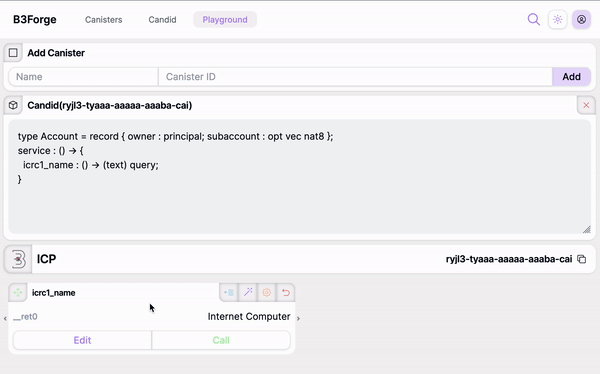Project Highlights
B3Forge is designed to centralize principles and standardize the interfaces for the essential parts of decentralized applications (dApps) that interact with digital assets and need to be trusted by users. It provides a set of tools and APIs that developers can use to create reliable and user-friendly applications for their own interfaces, while also making these applications available in the app store. This ensures that users can manage and transfer their assets seamlessly, even if problems arise.
Developers can use B3Forge to create customizable user interfaces for decentralized applications. Users can further tailor these interfaces based on their specific needs. For example, a user can customize the interface to manage only ICP and Bitcoin tokens without any additional functionalities. This flexibility allows users to design and implement interfaces that are perfectly suited to their unique use cases.
Web3 Advantages
Unlike traditional Web2 projects, which rely on centralized servers, B3Forge operates on decentralized networks. This means there is no single point of failure, enhancing security and reliability. Web3 projects give users more control over their data and assets. In B3Forge, users have full ownership and control over their interfaces and canisters, ensuring they are not dependent on a central authority.
B3Forge can seamlessly integrate with other dApps on the Internet Computer, allowing for greater flexibility and functionality. The open nature of blockchain technology ensures transparency. All transactions and interactions in B3Forge are transparent and can be audited, which builds trust among users. Additionally, Web3 projects often use tokens to incentivize users and developers. B3Forge could potentially integrate with token-based incentive models to reward users for their participation and contributions.
How Is It Built?
Technical Overview
B3Forge is built using JavaScript, leveraging the Candid interface provided by DFINITY. We created custom wrappers around the Candid visitor, which is available in the DFINITY repository, to enhance functionality and streamline the integration process. Each app’s data is stored securely on the Internet Computer, ensuring decentralized and reliable data storage. The backend, written in Rust, acts like an app store where interfaces created by users are stored based on their canister ID.
- Languages: JavaScript & Rust
- Frameworks: React for frontend development
- Libraries: ic-reactor, a set of packages we developed that wrap around agent-js, and custom wrappers around the Candid visitor from DFINITY
- 3rd Party Services: Integrated with Internet Identity for user authentication
Design Decisions
Key design decisions include using the Candid interface to compile the necessary data needed from generating the form to displaying the response in a customizable way. Additionally, we utilize a super-efficient storing approach that compresses a huge amount of customization into a single 32-byte chunk of data on the blockchain. This makes each app super small and storable safely without concerns about scalability. These choices ensure that B3Forge remains user-friendly and accessible to developers of varying experience levels.
Internet Computer Superpowers
B3Forge utilizes several unique features of the Internet Computer, such as:
- Seamless Canister Integration: Using Candid to enable smooth and efficient communication with canisters.
- Internet Identity: Ensuring secure and decentralized user authentication without relying on centralized systems.
- Scalability: Leveraging the Internet Computer’s scalability to handle growing user demands without compromising performance.
These features enhance the project’s capabilities, making it a robust and reliable tool for decentralized application development.
Go-To-Market Strategy
To attract users, we plan to engage with developer communities on platforms like the DFINITY forum, Twitter, and GitHub. We will share tutorials, conduct webinars, and participate in hackathons to demonstrate the capabilities of B3Forge. Partnerships with influential blockchain projects and thought leaders will also play a crucial role in our strategy. Additionally, we plan to implement the same functionality for Ethereum contracts, allowing users to add functions directly from Ethereum contract addresses and gain the same functionality. This integration will potentially attract a huge number of users to the Internet Computer (ICP).
Monetization
While B3Forge is currently focused on user adoption and feedback, future monetization strategies may include offering premium features, subscription plans, and providing customized solutions for enterprise clients. Decentralizing governance through an SNS (Service Nervous System) launch is also being considered to ensure community-driven growth and sustainability.
Status of the Project
We have successfully developed and tested the core functionalities of B3Forge. Our initial testing phase involved creating a simple ICRC token app, and the feedback has been promising. We are now inviting developers to engage with the tool, test it, and provide feedback on the DFINITY forum.
Future Plans
Our next steps include integrating more advanced customization options, enhancing the drag-and-drop functionality, and expanding the range of supported canister interactions. We also plan to attend major blockchain conferences and apply for grants to further develop and promote B3Forge.
We invite all developers to join us on this journey, test our tools, and provide valuable feedback. Together, let’s revolutionize decentralized application development with B3Forge.




